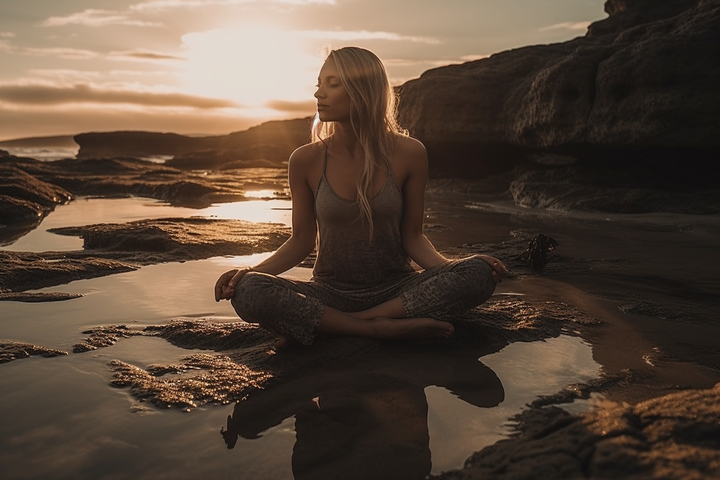Supported Savasana: The Cornerstone of Restorative Yoga
Incorporating Supported Savasana into your yoga practice is more than just a way to relax at the end of a session. This pose offers clear benefits for both body and mind. It improves heart health and balance, while also boosting mental clarity and reducing stress.

Supported Savasana, often referred to as the "corpse pose," is a restorative variation of the classic Savasana.
This pose serves as a catalyst for deep relaxation, healing, and rejuvenation. As you read through, you'll gain insights into the physical and mental benefits, step-by-step instructions, and other nuances that make Supported Savasana a holistic yoga experience.
Historical Background: Understanding the Roots of Supported Savasana
While Savasana has been a cornerstone of yoga practice for centuries, the concept of supported poses gained popularity with the rise of Restorative Yoga. Created by B.K.S. Iyengar, Restorative Yoga emphasizes the use of props to facilitate deep relaxation and healing. Supported Savasana is a direct result of this approach, aiming to make the benefits of the classic pose accessible to everyone.
Physical Benefits: Achieve Body Equilibrium
Supported Savasana is more than just a moment of rest at the end of a yoga session. When practiced correctly, this pose offers a myriad of physical benefits that can improve your overall well-being.
Muscular Relaxation
The supported nature of this pose allows for full muscular relaxation. When your body isn't having to hold itself up or maintain a particular position, the muscles can truly let go, decreasing tension and tightness.
Enhanced Circulation
By lying flat and allowing your body to be supported, blood flows more easily through the circulatory system. This helps to oxygenate cells and can promote faster recovery after exercise or stress.
Spinal Alignment
Lying flat on your back provides a neutral position for the spine. However, the addition of supports under the knees and lower back can enhance the natural curve of the spine, promoting better alignment and reducing strain on the back muscles.
Reduced Swelling in Extremities
With your legs slightly elevated, gravity can assist in the return of blood from the lower extremities. This is particularly useful for individuals who experience swelling in the legs or have poor circulation.
Respiratory Boost
The position of the body in Supported Savasana encourages deep abdominal and diaphragmatic breathing. This more efficient way of breathing allows for improved oxygenation of the body, contributing to overall health.
Improved Sleep Quality
Many practitioners find that adding Supported Savasana to their routine helps them to fall asleep faster and enjoy a deeper quality of sleep. The pose helps to set a state of physical ease that can transition into a restful night's sleep.
Mental Benefits: Attain Mental Clarity
Mental Benefits: Attain Mental Clarity
Supported Savasana isn't just a pose for your body; it's also a sanctuary for your mind. Engaging in this pose can offer profound mental benefits that go well beyond the yoga mat. Here's how:
Stress Reduction
When you fully relax your body, your mind tends to follow. The posture in Supported Savasana aids in activating the parasympathetic nervous system, also known as the 'rest and digest' system, counteracting the effects of stress and promoting relaxation.
Improved Focus and Concentration
By cultivating stillness in the body, you also cultivate stillness in the mind. As you focus on your breath and release tension, you train your mind to become more attentive and less prone to distraction. This heightened focus can then be applied to various aspects of daily life.
Emotional Balance
Supported Savasana provides a unique opportunity to check in with yourself emotionally. By allowing yourself the space to simply 'be,' you can better identify emotions that may be affecting you, offering a platform for emotional balance and self-regulation.
Mindfulness and Awareness
In the quietude of Supported Savasana, it becomes easier to cultivate a sense of mindfulness. You become more aware of your breath, the sensations in your body, and the thoughts that drift through your mind. This heightened awareness can extend to other moments in your life, enhancing your overall mindfulness.
Step-By-Step Instructions: Perfecting Supported Savasana
Mastering Supported Savasana may seem straightforward, but the subtle nuances can make all the difference in the world. Here's a step-by-step guide to ensure you maximize the physical and mental benefits of this restorative pose.
Step 1: Gather Your Props
Before you begin, gather any props you'll need—usually a yoga mat, a bolster or cushion, and optionally, a blanket and eye pillow.
Step 2: Prepare Your Space
Ensure you have a quiet, comfortable space to practice in. If possible, dim the lights, or perhaps light a candle, to create a soothing ambiance.
Step 3: Place the Bolster
Position your bolster or cushion horizontally at the top of your yoga mat. This will go under your knees to release tension in the lower back.
Step 4: Position Your Body
Sit down at the end of your mat and lie back, ensuring your legs rest on the bolster and your spine is aligned along the length of the mat.
Step 5: Adjust Your Arms
Place your arms beside you, palms facing upwards. Make sure your arms are at a comfortable distance from your body, allowing for natural shoulder relaxation.
Step 6: Head and Neck Alignment
Ensure your neck is in a neutral position. If it helps, you can place a small rolled-up towel under your neck for additional support.
Step 7: Optional Eye Pillow
If you have an eye pillow, you can place it over your eyes to help deepen the relaxation and block out any ambient light.
Step 8: Begin to Relax
Begin by taking a few deep breaths. Focus on the sensation of breath entering and leaving your body. Allow yourself to sink deeper into the mat with each exhale.
Step 9: Time in Pose
Stay in this pose for at least 5 to 15 minutes to allow ample time for relaxation and stress relief. If you find your head is turned to one side, make sure to balance your neck by turning it in the opposite direction for an equal amount of time.
Step 10: Exiting the Pose
To come out of the pose, remove any props from your body and roll gently to one side. Pause here for a few breaths before using your hands to help you sit up.
Common Mistakes to Avoid: Ensuring a Safe Practice
Supported Savasana may seem like a simple pose, but incorrect alignment or approach can minimize its benefits and even cause discomfort. Here are some common mistakes you should avoid to ensure a safe and effective practice.
Mistake 1: Incorrect Prop Placement
Improper placement of props can lead to discomfort and less effective relaxation. Make sure the bolster or cushion under your knees is positioned to provide adequate support, eliminating any strain on your lower back.
Mistake 2: Rushing into the Pose
It can be tempting to move quickly into Savasana, especially if it comes at the end of an intense yoga session. However, rushing might lead to poor alignment and reduced benefits. Take your time setting up your props and positioning your body.
Mistake 3: Holding Tension in the Body
Some people unknowingly hold tension in their jaw, shoulders, or even their fingers during relaxation poses. Periodically scan your body for tension and consciously relax those areas.
Mistake 4: Shallow Breathing
One of the main benefits of Supported Savasana is the opportunity to practice deep, mindful breathing. Shallow breathing reduces the calming benefits and can keep you in a state of mild stress. Focus on deep inhales and exhales.
Mistake 5: Being Too Cold
As you relax in Savasana, your body temperature may drop. Being too cold can be a distraction and make it difficult to fully relax. If this is the case, make sure to have a blanket handy to cover yourself.
Mistake 6: Uneven Neck Position
When you lay your head down, make sure your neck is in a neutral, comfortable position. As mentioned earlier, if your head is turned to one side, balance it out by turning it to the opposite side for an equal amount of time.
Mistake 7: Ignoring Physical Sensations
If you feel numbness, tingling, or any discomfort, it’s a sign that something isn't right. Don't ignore these signs; adjust your position or props as needed.
Mistake 8: Disruptive Environment
Choose a quiet and comfortable setting for your practice. Background noise or other disruptions can significantly impact the quality of your relaxation.
Modifications and Variations: Customizing the Pose
Supported Savasana is versatile, and there are various ways to adapt it to your personal needs or circumstances. Here are some modifications and variations to consider, making the pose accessible and comfortable for everyone.
Variation 1: Eye Pillow
Adding an eye pillow can deepen your sense of relaxation and shut out visual distractions. This small addition can be a game-changer in achieving mental clarity.
Variation 2: Heavier Blanket
If you find a light blanket doesn't keep you warm enough, try using a heavier one. Some people find the added weight comforting and grounding.
Variation 3: Leg Position
If having a bolster under your knees still leaves you with lower back discomfort, you can try bending your knees and placing your feet flat on the ground. This can change the pelvic tilt and offer more lower back support.
Variation 4: Arm Position
You can place your arms alongside your body, or stretch them out at a 45-degree angle from your torso. Experiment with both to find what feels best for you. You can also place small pillows or rolled towels under your arms for additional support.
Variation 5: Head Support
If the flat surface is uncomfortable for your neck or head, consider using a specialized yoga pillow or even a folded blanket for additional elevation.
Complementary Supported Poses: Deepen Your Relaxation
Incorporating other supported poses into your practice can significantly enhance the calming and rejuvenating effects of Supported Savasana. Here are a few supported poses that complement well and can be included in your yoga routine for a more holistic experience.
Supported Child's Pose (Salamba Balasana)
Supported Child's Pose is a beautiful way to transition in or out of Supported Savasana. It opens the hips, stretches the spine, and is a great posture for calming the mind. The added support makes it easier to stay in this pose for a longer duration, much like Supported Savasana.
Both poses encourage mental quietude and physical relaxation. Supported Child's Pose focuses on releasing tension in the back and hips, which is a wonderful contrast to the expansive relaxation of Supported Savasana.
Supported Bridge Pose (Setu Bandha Sarvangasana)
This pose enhances blood circulation and relieves fatigue, preparing your body and mind for the deep relaxation found in Supported Savasana.
Supported Forward Fold (Paschimottanasana)
This pose helps to prepare your body for Supported Savasana by encouraging spinal alignment and hamstring flexibility. The forward fold also has calming effects on the nervous system, making it easier to relax in Savasana.
Supported Reclining Twist (Supta Matsyendrasana)
The gentle twist prepares your body for the neutral alignment in Supported Savasana. It also aids in digestion and helps in relieving any tension or stiffness, adding a different dynamic to your relaxation practice.
Conclusion: The Profound Impact of Supported Savasana
Incorporating Supported Savasana into your yoga practice is more than just a way to relax at the end of a session. This pose offers clear benefits for both body and mind. It improves heart health and balance, while also boosting mental clarity and reducing stress.



Comments ()